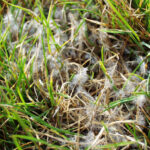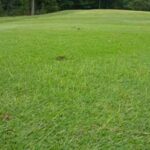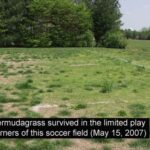Category: Disease Control
Turf Disease Watch
The near term forecast indicates an early arrival of summer, when temperature and moisture conditions favor diseases that can cause serious damage to turf on golf courses, athletic fields and residential landscapes. Two of the more important diseases are discussed below. Brown Patch Brown patch is a foliar disease that does not damage crowns or […]
Snow mold damage
Melting snows revealed some significant snow mold damage. As you know there are two types of snow mold diseases, gray snow mold (aka Typhula blight) and pink snow mold (Microdochium patch). Although they create similar symptoms (circular patches of tan turf—sometimes with orange/brown margins) the pathogens are not closely related and they have different temperature requirements for infection. […]
Damping off diseases in new seedlings
Although the cool weather tends to limit disease in new seedlings, a spike in the temperatures could trigger outbreaks in juvenile turf yet this year. Late summer is clearly the best time of the year to seed for a variety of reasons, but we must deal with two difficulties of seeding at this time: Our […]
Dollar Spot
Dollar spot is caused by a fungal pathogen, Sclerotinia homoeocarpa, that blights leaf tissues but does not affect turfgrass roots or crowns. The disease is a common concern on golf course turf, especially creeping bentgrass and annual bluegrass greens, tees, and fairways, where it can result in poor turf quality and appearance. Dollar spot is one […]
Rust Diseases
Rust is a disease of taller mown turf. Outbreaks are most common on residential lawns, low budget athletic fields, and, occasionally, on golf course roughs. A variety of related fungi cause rust. Ccommon names include leaf rust, crown rust, and stem rust, and the disease occurs almost exclusively on Kentucky bluegrass and perennial ryegrass. Rust […]
Professionals only: Rust/dollar spot thriving in lawns
The diseases rust and dollar spot are thriving in Indiana lawns right now, which is fairly typical for this time of the year. These are both low nitrogen diseases, so are almost inevitable as we try to keep lawns on the lean side during the summer to minimize devastating damage from pythium, brown patch, heat […]
Patch Disease Symptoms Starting to Show in Dry Kentucky Bluegrass Lawns
Summer patch and necrotic ring spot are root-infecting diseases in Kentucky bluegrass lawns. Their symptoms are some of the most difficult to manage, much less control the disease. Although these diseases differ slightly in when they attack the roots, the pathogens generally are active in the late spring to early summer. Infection-impaired roots have a […]
Rhizoctonia Spring Patches
Brown Ring Patch Brown ring patch is a disease of annual bluegrass on putting greens. Damage is largely cosmetic, although in some areas smoothness and uniformity of putting surfaces are disturbed, warranting chemical control. The duration of symptom expression usually is brief (one or two weeks), and coincides with mild weather with ample moisture. Despite […]
Yellow Patch Is Active!
Yellow patch, also referred to as cool season brown patch, is caused by Rhizoctonia cerealis, a fungus closely related to the pathogens that cause brown patch and the Rhizoctonia large patch of zoysia grass. Although symptoms can be striking, yellow patch causes only cosmetic damage and does not affect playability. It occurs most often on creeping […]
Winterkill in warm-season turfgrasses
Winterkill in warm-season grasses is highly variable and difficult to study by scientists. Because of this, our understanding of winterkill is based on science as well as practical experience and observation. Since winterkill in warm-season grasses can be affected by genetics, temperature extremes, and management factors, an endless combination of these factors can interact to […]
Rust on the rise in turf
With the warm dry weather slowing growth of most turf areas, rust is becoming common on many non-irrigated turf areas. Rust symptoms are reddish-orange lesions or spots on the leaf blades and a rust-colored powder that you can rub off with your fingers. Rust will rarely kill a turf area further then a lawn already […]
Gray Leaf Spot Update
We have just documented the first case of gray leaf spot this year from a golf course in Bloomington . We have learned that the disease will develop over a broad range of environmental conditions (not just hot and wet) and it continues to be very dry south of Indianapolis . Our research results showed […]
Something New in Golf Course Turf…Ghost Grass and Mad Tiller Disease???
Photo by: Steve McDonald of Turfgrass Disease Solutions located in Philadelphia Photo by: Cale Bigelow in West Lafayette Over the past week a relatively new turf malady has become prevalent on golf turf throughout the region. This new phenomenon has been referred to as “Mad Tiller Disease”, and “Ghost Grass” in the United Kingdom , […]
Brown Ring Patch / Waitea Patch
There are sporadic reports of brown ring patch (formerly called Waitea patch) from across the Midwest . Interestingly, the disease currently is causing concern in southern California as well. The risk of structural damage (a.k.a. dying turf) is greater on putting greens than on turf mowed at a half inch or higher. Otherwise, effects are […]
Bermudagrass Winter Survival and Cultivar Selection
With the bermudagrass damage in southern IN and Kentucky , we are fielding many questions on cultivar survival. Following is our winterkill data from 2003 of bermudagrass grown in West Lafayette under fairway conditions. Combining this data and other data from across the country, I would recommend in order the following cultivars of bermudagrass for […]
Winter damage on bermudagrass
As bermudagrass begins to green up in southern IN and Kentucky , it is apparent that moderate to severe winter damage has occurred. Though we may be a little premature because full green-up and growth is still a week or two away depending on temperatures, it’s important to start formulating a strategy to repair the […]
Brown Tracks in Lawn
With the mild drought stress over the last week, lawns are extremely susceptible to cosmetic damage from mowers, spreaders, and human traffic (photos). Drought stress may not have been easily visible before mowing. Turf likely was at the drought stressed stage where footprints (or mower tracks) remain in the turf and don’t snap back like […]
Lawns turning brown overnight?
We have received a number of calls, email, and electronic photos inquiring about brown patches to entire lawns turning brown apparently overnight (see photos). Following are the three most likely culprits: • Seedheads – Especially on perennial ryegrass lawns, seed heads mowed by an even a marginally sharp blade will fray and turn brown as […]
Gray Leaf Spot Update
There have been several reports of gray leaf spot outbreaks throughout Indiana and the lower Midwest during the past two weeks. The disease will develop over a broad range of environmental conditions (not just hot and wet). Our research results showed that the presence of inoculum is the disease-limiting factor north of the Ohio River. […]
Brown Patches in Lawns Could be Old Seedstalks
We have received a number of calls, email, and electronic photos inquiring about current brown patches in the lawn. Dollar spot is active throughout the state and could be causing problems in lawns. Dollar spot causes very noticeable lesions and cotton candy mycelium in the early morning. However, many of the patches that I have […]









